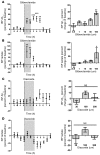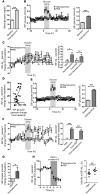Hyperglycemia modulates extracellular amyloid-β concentrations and neuronal activity in vivo
- PMID: 25938784
- PMCID: PMC4497756
- DOI: 10.1172/JCI79742
Hyperglycemia modulates extracellular amyloid-β concentrations and neuronal activity in vivo
Abstract
Epidemiological studies show that patients with type 2 diabetes (T2DM) and individuals with a diabetes-independent elevation in blood glucose have an increased risk for developing dementia, specifically dementia due to Alzheimer's disease (AD). These observations suggest that abnormal glucose metabolism likely plays a role in some aspects of AD pathogenesis, leading us to investigate the link between aberrant glucose metabolism, T2DM, and AD in murine models. Here, we combined two techniques – glucose clamps and in vivo microdialysis – as a means to dynamically modulate blood glucose levels in awake, freely moving mice while measuring real-time changes in amyloid-β (Aβ), glucose, and lactate within the hippocampal interstitial fluid (ISF). In a murine model of AD, induction of acute hyperglycemia in young animals increased ISF Aβ production and ISF lactate, which serves as a marker of neuronal activity. These effects were exacerbated in aged AD mice with marked Aβ plaque pathology. Inward rectifying, ATP-sensitive potassium (K(ATP)) channels mediated the response to elevated glucose levels, as pharmacological manipulation of K(ATP) channels in the hippocampus altered both ISF Aβ levels and neuronal activity. Taken together, these results suggest that K(ATP) channel activation mediates the response of hippocampal neurons to hyperglycemia by coupling metabolism with neuronal activity and ISF Aβ levels.
Figures



References
Publication types
MeSH terms
Substances
Grants and funding
LinkOut - more resources
Full Text Sources
Medical
Molecular Biology Databases

